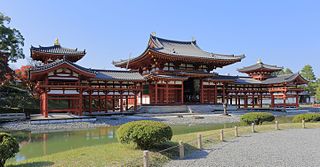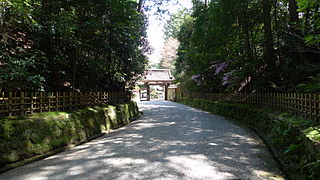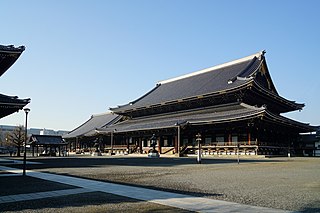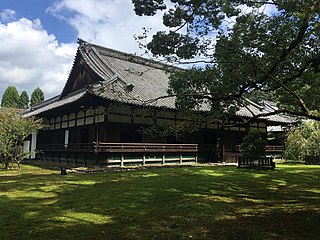 W
WBukkō-ji , also known as the "Temple of the Buddha's Light", was originally named Kosho-ji, a Jōdo Shinshū temple in the Yamashina ward of Kyoto, which later moved to the heart of Kyoto. The temple was founded and officially opened by a disciple named Ryōgen in 1324, but by the 15th century, Bukkō-ji was the largest and most successful temple, and its network of branch temples extending throughout the provinces of western Japan. As a rival to the Hongan-ji, it received much criticism for its evangelical practices from Kakunyo the head of the Hongan-ji. Around 1481, however, Bukkō-ji became a subordinate temple to the Hongan-ji. Many of the Bukkō-ji's congregation thus became members of the Hongan-ji, thus greatly reducing the stature.
 W
WByōdō-in is a Buddhist temple in the city of Uji in Kyoto Prefecture, Japan, built in late Heian period. It is jointly a temple of the Jōdo-shū and Tendai-shū sects.
 W
WChion-in in Higashiyama-ku, Kyoto, Japan is the headquarters of the Jōdo-shū founded by Hōnen (1133–1212), who proclaimed that sentient beings are reborn in Amida Buddha's Western Paradise by reciting the nembutsu, Amida Buddha's name.
 W
WChūgū-ji (中宮寺) is a temple in Nara Prefecture, Japan, that was founded as a nunnery in the seventh century by Shōtoku Taishi. Located immediately to the northeast of Hōryū-ji, its statue of Miroku and Tenjukoku mandala are National Treasures.
 W
WDaikaku-ji is a Shingon Buddhist temple in Ukyō-ku, a western ward in the city of Kyoto, Japan. The site was originally a residence of Emperor Saga, and later various emperor conducted their cloistered rule from here. The Saga Go-ryū school of ikebana has its headquarters in the temple. The artificial lake of the temple, Ōsawa Pond, is one of the oldest Japanese garden ponds to survive from the Heian period.
 W
WFor other temples by similar names, see Zenrin-ji.
 W
WEnshō-ji is a Buddhist temple complex in Nara founded by Queen Bunchi, daughter of Emperor Go-Mizunoo, in 1656. Together with Chūgū-ji and Hokke-ji, it is considered one of the Three Yamato Monzeki (大和三門跡), or imperial temples, belonging to the Myōshin-ji school of Rinzai Zen.
 W
WHigashi Hongan-ji (東本願寺), or, ″the Eastern Monastery of the Original Vow″, is one of two dominant sub-sects of Shin Buddhism in Japan and abroad, the other being Nishi Honganji. It is also the name of the head temple of the Ōtani-ha branch of Jōdo Shinshū in Kyoto, which was most recently constructed in 1895 after a fire burned down the previous temple. As with many sites in Kyoto, these two complexes have more casual names and are known affectionately in Kyoto as Onissan and Ohigashisan .
 W
WThe Hōjūjidono (法住寺殿) was a Buddhist temple in Kyoto which was, for a time, the home of the Cloistered Emperor Shirakawa II.
 W
WHokke-ji , is a Buddhist temple in the city of Nara, Japan.
 W
WKajū-ji , also sometimes spelled "Kwajū-ji" or "Kanshu-ji, is a Shingon Buddhist temple in Yamashina-ku, Kyoto, Japan.
 W
WManshu-in , also known as the Manshuin Monzeki, is a Tendai temple located near the Shugakuin Imperial Villa at Sakyō-ku, Ichijo-ji, Takenouchi-cho, in northeast Kyoto, Japan.
 W
WNinna-ji is the head temple of the Omuro school of the Shingon Sect of Buddhism. Located in western Kyoto, Japan, it was founded in AD 888 by the retired Emperor Uda. It is part of the Historic Monuments of Ancient Kyoto, a UNESCO World Heritage Site.
 W
WNishi Hongan-ji (西本願寺) is a Jōdo Shinshū Buddhist temple in the Shimogyō ward of Kyoto, Japan.
 W
WRinnō-ji (輪王寺) is a Tendai Buddhist temple buildings in the city of Nikkō, Tochigi Prefecture, Japan.
 W
WSanbō-in is a Buddhist temple in southern Kyoto, Japan, known today primarily for the quality of its garden.
 W
WSanzen-in (三千院) is a Tendai school monzeki temple in Ōhara, Kyoto, Japan. The Heian period triad of Amida Nyorai flanked by attendants is a National Treasure.
 W
WShōren-in (青蓮院) is a Buddhist temple in Kyoto, Japan. Also known as the Awata Palace, it was built in the late 13th century. Shinran Shonin, the founder of the Jodo Shinshu pure land sect, was ordained a monk at Shōren-in at the age of nine.